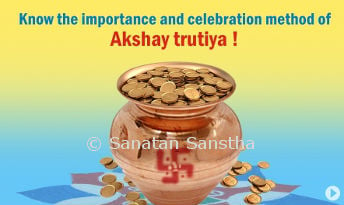
1. Tithi of the festival
Vaishakh Shukla Trutiya (Third day of the bright fortnight of the Hindu lunar month of Vaishakh) is known as Akshaya Tritiya. Akshaya Tritiya is the day when Satyayug ended and Tretayug began. Today, a vrat is often observed and there are several important aspects. Let’s learn the method of celebration, the significance of “Til-tarpan” and “Udak-kumbh” on this auspicious day and much more.
Videos related to Akshaya Tritiya
2. It is a day that imparts eternal benefits
It has been stated in an ancient Sanskrut Holy text named Madanratna that Bhagavan Shrikrushna has narrated importance of this day to Yudhishthir. He says,
अस्यां तिथौ क्षयमुर्पति हुतं न दत्तं । तेनाक्षयेति कथिता मुनिभिस्तृतीया ।।
उद्दिश्य दैवतपितृनि्क्रयते मनुष्यैः । तत् च अक्षयं भवति भारत सर्वमेव ।। – मदनरत्न
Meaning : (Shrikrushna says) O Yudhishtir, the offerings made and the oblations offered in the sacrificial fire on this day never go in vain. Hence, Sages have imparted the name Akshaya Tritiya to this day. Everything done on this day for the sake of Deities and ancestors is Akshay, meaning they are imperishable.
3. It is a day that marks the end of Satyayuga and the beginning of Tretayuga
In every Yug (Era), with passage of time, sāttviktā (Sattva-predominant) goes on decreasing, meaning the effect of Raja- Tama goes on increasing. Capacity of human beings to perform spiritual practice decreases and they do not abide by Dharma. This destroys righteousness. In such situation, God incarnates for the purpose of establishment of Dharma and creates appropriate means of spiritual practice which can be followed by human beings. It helps in increasing sāttviktā and beginning of Satyayuga of the next Era. This transition period is known as Shunya-kal or Kalah-kal. As per Hindu Scriptures, the Day marking the ending of one Era and beginning of the other is considered to be very important. It marks the end of Kalah-kal of one Era and commencement of the Satyayug of the next Era. This period, meaning the muhūrt (Auspicious time) or the auspicious time lasts for a few moments; but its effect lasts for next 24 hours. Therefore, the whole day is considered to be auspicious.
4. It is a day on which the incarnations manifest
On the day of Akshaya tritiya, incarnations of God like Hayagreeva, Parashuram and Naranarayana manifested.
5. It is one among the 3-1/2 auspicious time
Akshaya Tritiya is also considered to be one of the 3-1/2 auspicious muhūrt (Auspicious days) in Hindu Dharma. To be precise, the 3-1/2 auspicious muhūrt are – Chaitra Shukla Pratipada, meaning the New Year, Vijaya Dashami and Akshaya Tritiya. These are the 3 muhūrt and Bali Pratipada is taken as half muhūrt. Every second of this day is auspicious. Offerings made on this day and Havan (sacred fire) performed on this day never wane; it means one gets its fruits; therefore, many people make offerings on this day on large scale.

Significance of Satpaatre Daan (donation to deserving person) !
It is the duty of every person to donate for deserving cause/person, as per Hindu Dharma. Donating to deserving means donating for activities carried out for protection of ‘Sat’. Making offerings results in increasing merits; while making such offerings to deserving person/cause leads to even spiritual benefits, along with merits.
Hindu Janajagruti Samiti (HJS) is a non-govt charitable trust working for welfare of society, nation and Dharma. Interested in making offerings on the occasion of ‘Akshay Trutiya’.
6. Increase in sattvikata of the earth
On the day of Akshaya Tritiya, the Brahma and Shrivishnu Principles jointly descend to Earth. It increases the sāttviktā of the Earth by 10 %. So far, we have learnt about various reasons associated with the importance of Akshaya Tritiya.
7. Method of celebrating the festival
Since Bharatiyas always consider the first day of any time period to be auspicious, the scriptures prescribe rituals like ritualistic bathing, donations etc. on such days. The ritual performed on this day includes a bath with sacred water, puja (Ritualistic worship) of Shrivishnu, chanting, a hom (Fire-sacrifice performed to appease Deities), donations and pitrutarpan (offerings to ancestors). It is recommended that Apindak shraddh (rite for departed ancestors) be done on this day and if this is not feasible, then at least an offering of sesame seeds should be made. Offerings should be only to the deserving. Offering to Saints or spiritual Organisations spreading righteousness in society is an offering to the deserving. By offering to the deserving, the act of donating becomes akarma-karma (An act, action which despite being a karma bestows the benefits of akarma [An act, action which does not give rise to destiny]). The account of merits-sins is not applicable to an akarma-karma. Therefore, the donor is not entrapped in any kind of attachment and this helps his spiritual progress.
Akshay Trutiya has a special significance for women in Maharashtra. On this day, On this day, they are supposed to immerse Chaitragouri (the female Deity Gouri) worshipped by them in the lunar month of Chaitra. They also arrange ‘Haldi-kumkum’ ceremony (where a married woman applies haldi (turmeric powder) and kumkum (vermilion) to other married women).on any Tuesday or Friday between Chaitra Shukla Trutiya and Vaishakh Shukla Trutiya.
8. Meaning and purpose of til-tarpan
Til-tarpaṇa means offering til (sesame seeds) and water to Deities and ancestors. Meaning of tarpan is offering water to Deities and ancestors; meaning, offering water through thumb side of the palm of right hand to make them happy. Water offered for ancestors is called as Pitru-tarpan. Ancestors expect from their descendants offering of Pinḍa and Brāhmaṇ-bhojan; similarly, they expect to get water. By doing tarpan, ancestors are satisfied. Til symbolize sāttviktā and water symbolizes pure bhav. Deities are offered white til and ancestors are offered black til. Black til emit frequencies of Raja/ Tama components; with the help of which insatiate souls of ancestors can easily come to the place on Earth where such rite is being performed. They have part of offering made in such rite and they are satisfied.
9. Method of performing til-tarpan to Deities
A. First hold a round, shelving metal dish of copper in hand.
B. Remember Brahma and Shrivishnu and their joint form Shri Dattatreya and pray to them to descend to that dish.
C. Have the bhav that Deities have descended to the copper dish in their subtle form.
D. Take white til and with a bhav of offering them to Deities, let them flow from palm through fingers into the copper dish below by pouring water on the palm, so that they fall in the dish.
E. Fold hands and pay obeisance to Deities.
This is the method of til-tarpan for Deities. When til and water are offered with bhav to Deities, individual making such offering can imbibe sāttviktā of the Deities to larger extent.
10. Importance of til-tarpan to ancestors on the day of Akshaya Tritiya
On this day, sāttviktā from higher regions reaches earth to a greater extent. Many souls from Nether region come close to earth on this day to imbibe this sattvikata. This can cause distress to human beings. Distress due to insatiate ancestors’ souls is about 30 to 40%. As their souls come close to earth, they get energy through the til-tarpan and also attain momentum for further journey.
11. Manner of performing til-tarpan for ancestors for their momentum after death
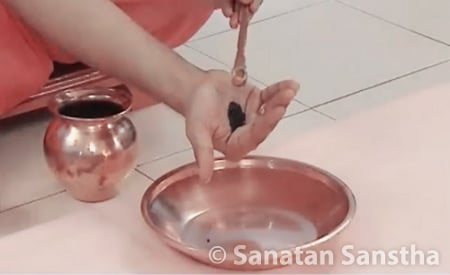
A. Take a round, shelving metal dish of copper and pray to ancestors to come to the dish.
B. Maintain bhav that ancestors have descended in subtle form into the dish.
C. Take black til (Sesame seeds) in hand.
D. Pray to Shrivishnu and Brahma for til to get charged with their Principles.
E. Then, such til charged with the Principles of Deities, should be offered in the round, shelving metal dish of copper along with water may through the space between thumb and index finger. Have the bhav that you are offering til and water to ancestors.
F. Pray to Deity Dattatreya, Brahma or Shrivishnu for smooth onward journey of ancestors’ souls.
12. What is the effect of til-tarpan ?
Ancestors love til (Sesame seeds) and negative energies do not create obstacles in the ritual performed for the sake of ancestors when til are used. Til have greater capacity to imbibe sāttviktā and destroy Raja/Tama. Upon invoking the subtle-bodies of the ancestors while performing til-tarpan, they enter the copper shelving dish as per the bhav of the individual performing the ritual. These subtle-bodies have a distressing covering around them. Upon performing the til-tarpan, these subtle-bodies imbibe sāttviktā. The subtle-body that is satisfied with the ritual, starts losing the distressing covering and a protective covering of chaitanya begins to get formed around the subtle-body. It also acquires energy and vital energy necessary for its onward journey. As a result, the subtle-body losses its grossness, becomes light in weight and acquires momentum. Owing to til-tarpan, distress caused by ancestral problems reduces by about 5 to 10%. By performing til-tarpan on the day of Akshay Trutiya, the individual performing it is able to repay his debt unto the Deities and ancestors to some extent.
13. Importance of making offerings on the day of Akshaya Tritiya
The offering made on this day is everlasting. It has been stated in Puranas to make offerings of good raw grain, udak-kumbh, meaning a pot filled with water, fan made of khus (Root of Andropogon muricatus grass), umbrella, shoes/ footwear etc. on the day of Akshaya Tritiya for the sake of ancestors.

14. Purpose of offering udak-kumbh (Water-pot )
to Brahmans in the name of Deities and ancestors
Udak-kumbh is termed as a nirguṇ (Non-materialised) pot that is at all encompassing level. When udak-kumbh is offered for the sake of ancestors, they eliminate our desires. So also the God’s blessings obtained through the act help eliminate our demerits generated through our karmas. Our subtle desires generated due to our karmas are offered at the Holy feet of God in the form of this offering. The meaning of offering udak-kumbh filled with water is by treating the water filled in the pot as sacred, immersing all kinds of our desires related to body and karma into that pot, purifying our body by destroying desires with karma performed without any expectations, and then offering all such desires at the feet of a Brahman through the medium of udak-kumbh treating him as a form of Deity and ancestor.
15. The ceremony of offering udak-kumbh
In the kalash (pot) kept for Deities, Shrivishnu is instated by the name of Vasant-Madhav and puja is performed; however, all the ancestors are invoked in the kalash kept for ancestors, and puja is performed.
16. The arrangement of the implements
used in the puja ceremony and the actual ritual ceremony
Keep two short stools, one for Deities and the other for ancestors. Place on them heaps of rice grain as per your capacity and two round, shelving metal dishes of copper. Keep kalash over them. Keep a coconut near the kalash; so also keep couple of betel leaves separately for each kalash. Then keep a betel nut and dakshina (monetary offering) on them. Keep fruit for offering as naivedya. In the kalash, kept for Deities, put a betel nut and white til and black til and betel nut in the kalash kept for ancestors. Before starting kalash-puja, perform achaman, pranayam and pronounce desh-kal and make a resolve. Put a new cloth around the kalash. Pray and invoke Vasant-Madhav in the kalash for Deities and perform its puja. Similarly, perform the puja of kalash for ancestors. After kalash-puja, perform Brahman-puja and kalash for Deities is donated to the Brahman. Pray for welfare of all. Similarly, kalash for ancestors may also be given to Brahman. Pray to God for peace and happiness of the souls of ancestors and for their smooth onward journey.
A. Mantra to be recited while donating an Udakumbha to a brahman
एष धर्मघटो दत्तो ब्रह्मविष्णुशिवात्मकः ।
अस्य प्रदानात् तृप्यन्तु पितरोऽपि पितामहाः ।।
गन्धोदकतिलैर्मिश्रं सान्नं कुम्भं फलान्वितम् ।
पितृभ्यः सम्प्रदास्यामि अक्षय्यमुपतिष्ठतु ।। – धर्मसिन्धु
Meaning : I have donated this dharmaghat (kalash or pot), which contains Brahma, Vishnu and Shiva to the Brahman. Let my ancestors and the Deities be satisfied with this act. I am offering this dharmaghat with gandh (sandal), udaka (water), til (sesame seeds), yava (barley) and phal (fruits) to my ancestors. Let this kumbha (kalash) always prove akshaya (imperishable) to me.
17. The effect of offering udak-kumbh to ancestors
A. Chaitanya (Divine consciousness) remains active in the atmosphere in the form of particles.
B. Emotion of gratitude towards the ancestors is generated in individual performing the puja of udak-kumbh and a ring of bhav is generated on his anahat-chakra.
C. A ring of chaitanya keeps on revolving in the udak-kumbh worshipped thus.
D. Upon performing the puja, a ring of Shakti keeps on revolving inside the udak-kumbh.
E. Waves of the ancestors get drawn towards kumbh from Pitru-loka.
F. These waves, owing to the presence of water and black til and the betel nut in the kalash, remain in a ring form and that ring keeps on revolving in activated form.
G. While offering the udak-kumbh to the Brahman, a Sattva-predominant ring gets activated on the anahat-chakra of the individual.
H. A Sattva-predominant flow commences from the individual making the offering towards the Brahman accepting the offerings.
I. A Sattva-predominant ring is generated on the anahat-chakra of the Brahman accepting the offerings.
J. A flow that accommodates the subtle-bodies remains activated from the Bhu-lok (Earth region) to the Pitru-lok (Region of the dead).
K. Dissatisfied ancestors dwell in this flow in the form of subtle-bodies.
L. Distressing covering of un-fulfilled desires on these subtle-bodies is eliminated. They acquire momentum and depart for their onward journey and they go to the next region.
M. A flow of chaitanya in the form of blessings commences from the ancestors to the individual.
N. Distressing covering on the individual gets eliminated.
O. A protective covering is formed all round the individual.
18. Other customs followed alongwith
offering of udak-kumbh and til-tarpan on the day of Akshaya Tritiya
On this auspicious day, seeds are sown. Puja of soil is performed and trees are planted. At some places, drinking-water is provided to people.

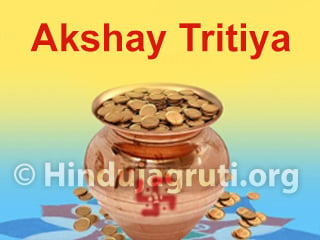
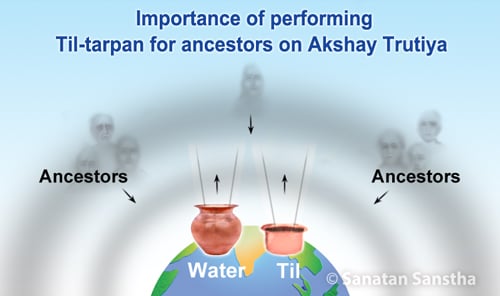
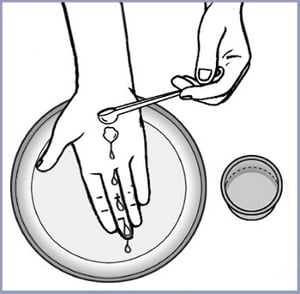
 Holi festival and Rang panchami
Holi festival and Rang panchami Chaitra Shukla Pratipada (Gudi Padwa)
Chaitra Shukla Pratipada (Gudi Padwa)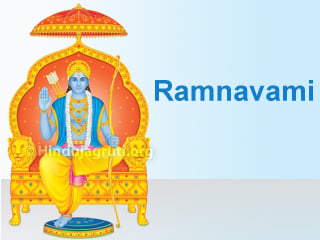 Ram Navami
Ram Navami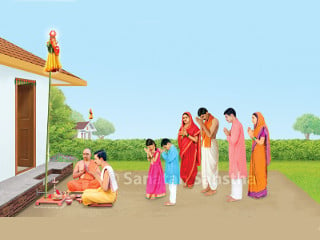 Purpose of celebrating Religious festivals and Vrats
Purpose of celebrating Religious festivals and Vrats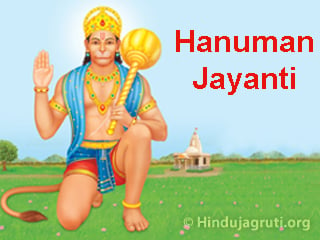 Hanuman Jayanti
Hanuman Jayanti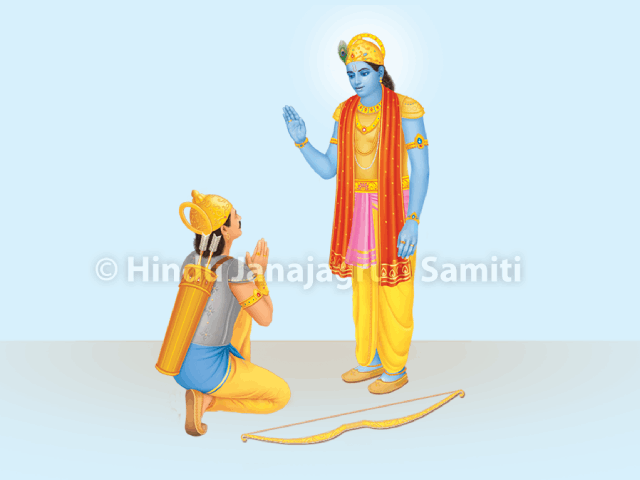 Guru Purnima Mahotsav 2024
Guru Purnima Mahotsav 2024